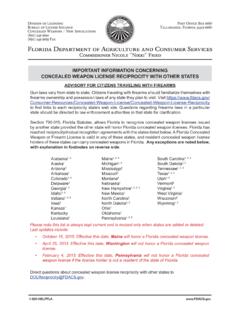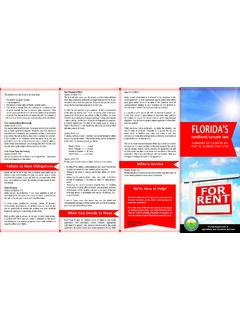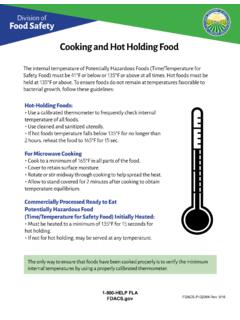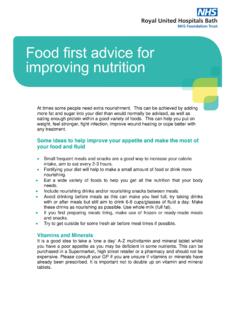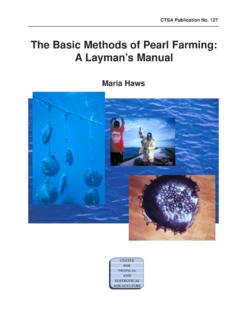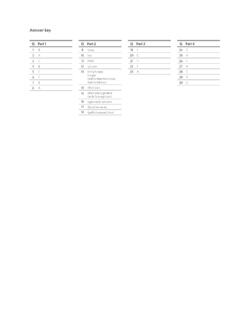Transcription of Florida’s Hurricane History
1 Preparation and Recovery from FDACS-P-01461 Technical Bulletin #02 - Updated July 2020 Division of Aquaculture 600 South Calhoun Street, Suite 217 Tallahassee, Florida 32399-1300 Main Office: (850) 617-7600 Overview: Florida s Hurricane History Family and farm Disaster Planning Shellfish Harvest Area Closures Post Hurricane Shellfish Plant Inspection Disaster Recovery Information Safeguarding the public and supporting Florida s agricultural economy. Hurricane Facts The official Atlantic Hurricane season runs from June 1 to November 30 every year. These dates encompass 97% of tropical Hurricane activity. There were 1,065 hurricanes in the North Atlantic from 1851-2019, an average of per year. September is the most active month of Atlantic Hurricane season, representing 49% of total hurricanes that occurred from 1851-2016.
2 38% of all hurricanes have hit Florida. Approximately 90% of Hurricane fatalities occur in water-related incidents, with 49% occurring from storm surge. Hurricane Irma is now Florida s costliest Hurricane to date, with an estimated $58 billion in economic losses. Florida s Hurricane History Paths of major hurricanes (Category 3 or higher) over Florida from 1851-2019. Figure Credit: National Oceanic and Atmospheric Administration Florida leads the nation in direct Hurricane hits for the period 1851 to 2019. Florida experienced 50 major hurricanes (Category 3 or greater) during this period as compared to the next highest states: Texas (25), Louisiana (22), North Carolina (10) and South Carolina (8). Thirty-eight percent of all hurricanes have hit Florida; 70 percent of hurricanes at a Category 4 or higher have hit either Texas, Louisiana or Florida.
3 The threat of major hurricanes increases from west to east as the Hurricane season progresses each year. As such, Texas and Louisiana are the prime targets for early season hurricanes, while the east coast of Florida is most likely to be impacted inOctober each year. Regardless of this trend, September remains the peak of Hurricane season with as many major Hurricane landfalls as October and August combined. The earliest Hurricane on record to strike Florida was Alma on June 9, 1966, while the latest to strike Florida was Kate on November 21, 1985. Six of the top ten costliest hurricanes in History have impacted Florida. The state s population is increasing an average of percent annually, with million more residents from 2010 to 2016. As Florida s population continues to expand, projected at 25 million by 2030, the economic impacts from hurricanes are also increasing.
4 Population growth is predominantly occurring less than 50 miles from the coastline, further exacerbating the potential economic damage. For example, all three hurricanes making landfall in 2008 made the top 30 list of costliest hurricanes in History , despite none of them being major hurricanes at landfall. Fortunately, due to an increase in Hurricane preparation, planning and forecast and warning systems the number of fatalities per Hurricane is in decline. The perpetual threat of hurricanes in Florida, in combination with the state s growing population and economy, emphasize the importance of wise business planning and storm preparedness. Information from NOAA Historical Hurricane Tracks database. FDACS-P-01461 Rev. 07/20 Technical Bulletin Preparation and Recovery from Hurricanes Page 2 Shellfish Harvest Areas Closures During a Hurricane When a Hurricane warning is issued by the National Weather Service, Division staff temporarily close shellfish harvest areas (SHA) included in the warning at sunset.
5 These precautionary emergency closures are in anticipation of storm surge, heavy rainfall and power outages at waste water treatment plants that could contaminate SHAs with surface water runoff. If the Hurricane does not strike the area and the anticipated damage does not occur, then SHAs will be immediately reopened the following day at sunrise. However, if SHAs are impacted, Division staff will systematically collect water samples and shellfish meat samples for testing to reopen SHAs and ensure a safe and wholesome product can enter the supply chain. For more information about SHAs closures, contact the Division by email at by phone at (850) 617-7600 or by visiting: Family and farm Disaster Planning Discuss the type of hazards that could affect your farm and family. Know your vulnerability to storm surge, flooding and wind.
6 Develop standard operating procedures for preparing for a Hurricane and maintaining your facility when you cannot access critical services. Test emergency backups systems (for example, generators and auxiliary oxygen systems) and secure extra fuel supplies if possible. Place your farm on a priority reactivation list with your utility, fuel or oxygen supplier. Post up-to-date contact information for all employees, and make sure everyone knows how and when to call 911. Check your farm s insurance coverage. Take photos of the facility, machinery and inventory before a storm for records. Secure outdoor objects that may become a hazard during high winds. Determine escape routes from your home or farm and places to meet. Stock non-perishable emergency supplies and a disaster supply kit. Use a NOAA weather radio and replace its battery every six months.
7 The Federal Emergency Management Agency (FEMA) provides a wealth of information on preparation and recovery from hurricanes. Find information specific to your area at: Stopping Price Gouging During Emergencies During a state of emergency the State of Florida may invoke a price-gouging statute. This statute makes it illegal to charge excessive or exorbitant prices for essential items, including shelter, gasoline, food, water, ice, lumber or generators, unless the increases in the amount charged are attributed to additional costs incurred by retailers. Individuals or businesses found to have engaged in price gouging face fines of up to $1,000 per violation, or up to a maximum fine of $25,000 per day. The Department encourages residents who witness what they believe are price gouging incidents to report it at once to the Department s price-gouging hotline: (800) HELP-FLA (435-7352)Post Hurricane Shellfish Plant Inspection After a Hurricane , the following actions are implemented to determine whether shellfish processing plants are capable of producing wholesome products.
8 Division staff call the plants that have been impacted by the storm. If contact is made , staff determine if there was loss of power, the length of time power was lost, the type and amount of product on hand, the measures taken to insure temperature abuse has not occurred ( , ice, portable generators, refrigerated vehicles or trailers), the integrity of water supply, the extent of facility damage, the extent of storm surge and length of time for repairs. Plant management will be informed of what actions will be necessary before processing can resume. Staff will then follow up with an in-person inspection as soon as practical. If no phone contact can be established, staff will conduct an onsite inspection as soon as it is safe to do so. Special attention is given to structural integrity, water supply, cooling systems and ice production.
9 Plant management will then be informed of what actions will be necessary before processing can resume. When processing plants have extensive damage, the processing certification may be suspended. The Department notifies the Food and Drug Administration as to the status of processing plants listed on the Interstate Certified Shellfish Shipper List. FDACS-P-01461 Rev. 07/20 U Technical Bulletin Preparation and Recovery from Hurricanes Page 3 farm Disaster Recovery Information After a Presidential Disaster Declaration is signed, individuals and farms should contact FEMA at (800) 621-3362 or to apply for assistance and receive a FEMA application number. Once an application is processed, further assistance will be available at Disaster Recover Centers. Federal, state and local representatives will be available at the Centers to assist with recovery.
10 The following programs may be available to assist your aquaculture business with recovery efforts. Small Business Administration offers low interest loans to individuals and businesses for refinancing, repair, rehabilitation or replacement of damaged property (real and personal). For more information see: Disaster Unemployment Assistance is for individuals not covered by regular state or private unemployment insurance. Individuals may be eligible for unemployment benefits that can be provided until an individual is re-employed or up to 26 weeks after the major disaster is declared (whichever is shorter). For more information, see: farm Service Agency offers low interest disaster loans to farms, ranchers and agricultural operators for physical or production losses. Loans of up to 80 percent of actual production loss or 100 percent of the actual physical loss, with a maximum indebtedness of $500,000, may be made to the tenant or owner.

